Ukraine is a country in Eastern Europe. It is the second largest country in Europe after Russia, which borders it to the east and north-east.
The territory of modern Ukraine has been inhabited since 32,000 BC. During the Middle Ages, the area was a key centre of East Slavic culture under Kievan Rus’, which was ultimately destroyed by the Mongol invasion in the 13th century. Over the next 600 years, the area was contested, divided, and ruled by external powers, including the Polish–Lithuanian Commonwealth, the Austrian Empire, Austria-Hungary, the Ottoman Empire, and the Tsardom of Russia. The Cossack Hetmanate emerged in Central Ukraine in the 17th century but was partitioned between Russia and Poland, and ultimately completely absorbed by the Russian Empire. In the aftermath of the Russian Revolution a Ukrainian national movement re-emerged, and the Ukrainian People’s Republic was formed in 1917. This short-lived state was forcibly reconstituted into the Ukrainian Soviet Socialist Republic, which became a founding member of the Soviet Union (USSR) in 1922. From 1932 to 1933 the Holodomor killed millions of Ukrainians. In 1939, Western Ukraine was annexed from Poland by the USSR. Ukraine was the most populous and industrialised republic after the Russian Soviet Republic. With the dissolution of the Soviet Union Ukraine regained its independence in 1991.
Ukraine is among the poorest countries in Europe and suffers from widespread corruption. However, due to its extensive fertile land, pre-war Ukraine was one of the largest grain exporters in the world.it is a member of the United Nations, the Council of Europe, the OSCE, the GUAM organization, the Association Trio, and the Lublin Triangle.
1.Chernobyl

The 9/11 Memorial at Ground Zero in New York City, Alcatraz in San Francisco, Pearl Harbor, Pompeii, and The Killing Fields of Cambodia are all popular examples. Visitors to Ukraine can add the Chernobyl Nuclear Power Plant, ground zero for the disaster, to the list.
The Chernobyl disaster was a nuclear accident that occurred on 26 April 1986 at the No. 4 reactor in the Chernobyl Nuclear Power Plant, near the city of Pripyat in the north of the Ukrainian SSR in the Soviet Union. It is considered the worst nuclear disaster in history both in cost and casualties.
The accident occurred during a safety test on the steam turbine of an RBMK-type nuclear reactor. During a planned decrease of reactor power in preparation for the test, the power output unexpectedly dropped to near-zero. The operators were unable to restore the power level specified by the test program, which put the reactor in an unstable condition. This risk was not made evident in the operating instructions, so the operators proceeded with the test. Upon test completion, the operators triggered a reactor shutdown. However, a combination of operator negligence and critical design flaws had made the reactor primed to explode. Instead of shutting down, an uncontrolled nuclear chain reaction began, releasing enormous amounts of energy.
2.St. Sophia’s Cathedral
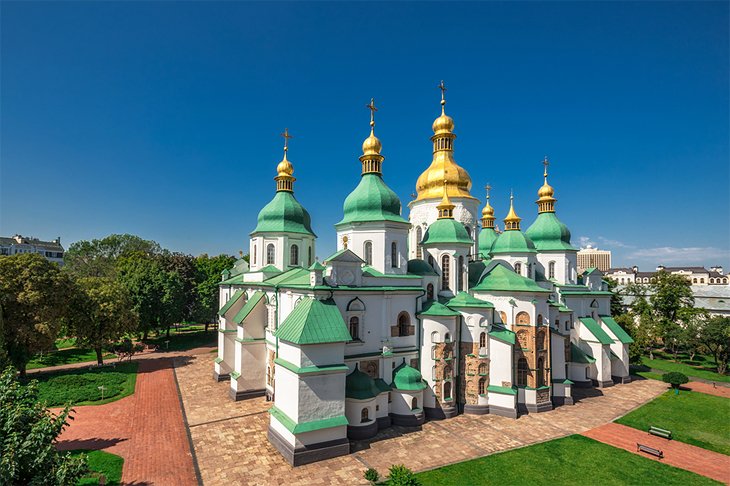
Saint Sophia Cathedral in Kyiv, Ukraine, is an architectural monument of Kyivan Rus. The former cathedral is one of the city’s best known landmarks and the first heritage site in Ukraine to be inscribed on the World Heritage List along with the Kyiv Cave Monastery complex.
In Ukrainian the cathedral is known as Sobor Sviatoi Sofii (Собор Святої Софії) or Sofiiskyi sobor (Софійський собор).
The complex of the cathedral is the main component and museum of the National Sanctuary “Sophia of Kyiv” which is the state institution responsible for the preservation of the cathedral complex as well as four other historic landmarks across the nation.
The cathedral is named after the 6th-century Hagia Sophia (Holy Wisdom) cathedral in Constantinople (present-day Istanbul), which was dedicated to the Holy Wisdom rather than to a specific saint named Sophia.
This has been accepted by both UNESCO and Ukraine, which officially celebrated the 1000th anniversary of the cathedral during 2011. The structure has 5 naves, 5 apses, and (quite surprisingly for Byzantine architecture) 13 cupolas. It is surrounded by two-tier galleries from three sides. Measuring 37 to 55 m (121 to 180 ft), the exterior used to be faced with plinths. On the inside, it retains mosaics and frescos from the 11th century, including a dilapidated representation of Yaroslav’s family, and the Orans.
3.Visit L’viv’s Historic Center, a UNESCO World Heritage Site
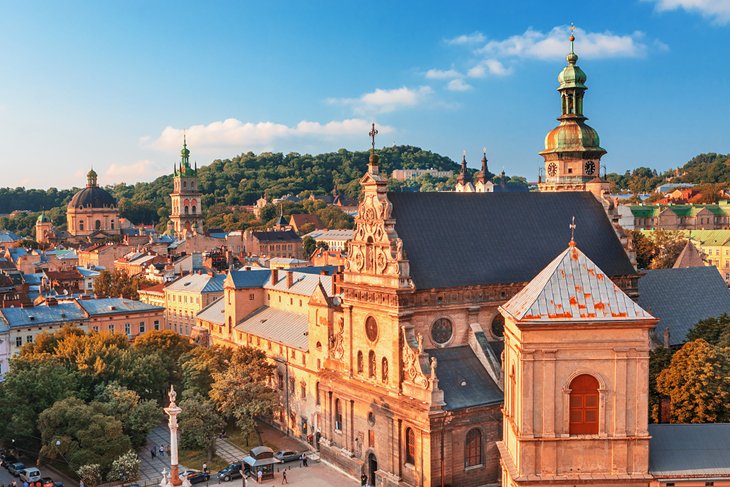
Lviv’s Old Town is the historic centre of the city of Lviv, within the Lviv Oblast in Ukraine, recognized as a State Historic-Architectural Sanctuary in 1975.
Beside the listed items of three major areas there are some 2,007 other historical landmarks within the Old City’s area, 214 of which are considered national landmarks.
Pidzamche (Sub-castle)
High Castle and Sub-castle neighborhood, the original center of the city also containing the neighborhood of Old Market Square, the castle was preserved in ruins, however the general area of the city is better known for its name
Church of St.Nicholas, the family church of the Halychyna (Ruthenian) kings
Church of St.Paraskeva-Praxedia (Good Friday), contains 1740 inconostasis of the church by Fedor Senkovych
Church of St.Onuphrius and Basilian Monastery, contains artworks of Lazar Paslavsky and Modest Sosenko
Church of St.John the Baptist (today – Museum of Lviv Ancient relics), the church was dedicated to the Hungarian wife of King Leo, Constance, a daughter of King Béla IV
Church of Snowy Mary (today – Our Lady of Perpetual Help Church), the church of German colonists of the city.
Old Town landmarks that are not part of the World Heritage Site
Church of Carmelites, the Barefooted (today – Church of St. Michael)
Church and Nunnery of Carmelites, the Barefooted (today – Church of Purification)
Church of Poor Clares (today – Museum of Sacral Baroque Sculpture)
Church of St.Martin (today – Baptist Church)
Church of Transfiguration
Church of St.Casimir
Lviv Theatre of Opera and Ballet
Potocki Palace, Lviv, currently a residence of the President of Ukraine
Commodity Stock Exchange.
4.Bukovel
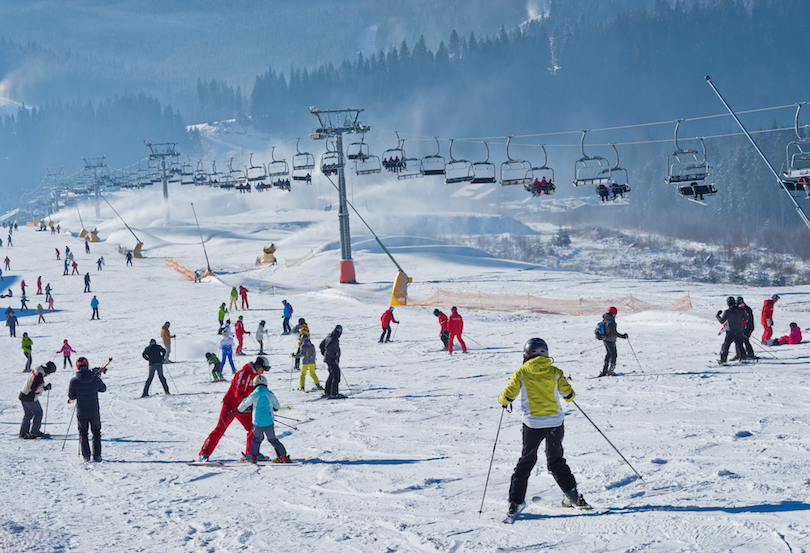
The resort was pioneered in 2000 by a joint venture of Scorzonera Ltd. and Horizont AL as an all-year-round tourist and recreational complex. The research for potential ski fields and cableways of the first stage was conducted in cooperation with Plan-Alp, Austria, and Ecosign, Canada, who also finalized the master plan for the resort. By late 2001, a first 691-meter ski lift was launched at the Northern slope of Mountain Bukovel along with the projected chairlift ropeway at the Bukovel’s north-western slope. The project was finished in Sept.-Oct. 2002 as a 1000-metre ropeway. In 2003, a second slope, 2A ski run with a chairlift was introduced, and in 2004 a 7A ski run with a surface lift started its operation.
An idyllic wintertime destination, Bukovel is Ukraine’s big skiing destination. In fact, it’s the largest ski resort in Eastern Europe! Surrounded by three mountains, including the highest peaks of the Carpathians, the views from this luxury alpine ski resort are simply breath-taking.
Bukovel Ski School was set up in 2001 by the Bukovel Ski Resort and ski and snowboarding coaches. It trains people of all ages, as well as provides training grounds for professional sportsmen. The School promotes skiing and health programmes. During each season the Bukovel Ski Schools organizes over 30 ski and snowboarding events for children, amateurs, professional sportsmen and coaches. In the summertime the School holds a children’s health and sports camp programmes and other leisure events for Bukovel’s visitors.
5.Chernivtsi
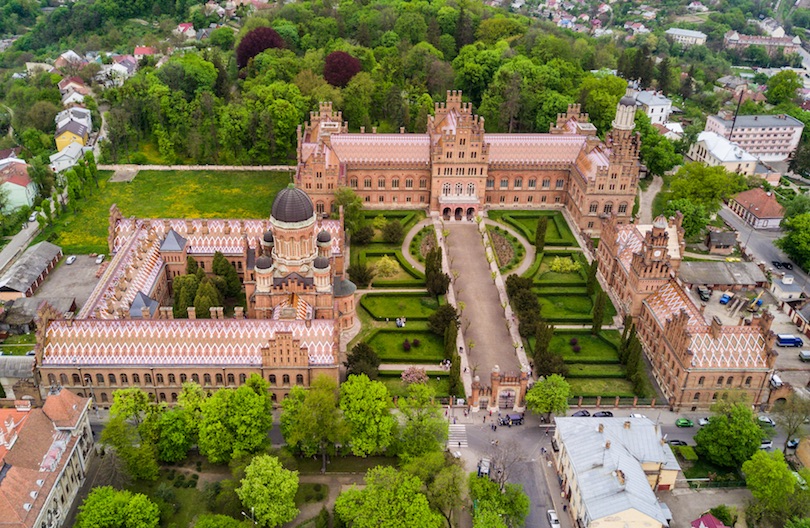
Chernivtsi is a city in western Ukraine. It’s known for the 1875-founded Chernivtsi National University, which features Romanesque and Byzantine architecture and the Chernivtsi University Botanical Garden. At the heart of the old town is Central Square, with the blue, neoclassical City Hall. Nearby, the Chernivtsi Museum of Art exhibits 17th- to 20th-century art from the historic region of Bukovina in a former bank.
Aside from its Ukrainian name of Chernivtsi, the city is also known by several different names in various languages, which still are used by the respective population groups much as they used to be throughout the city’s history, either in connection with the rule by one country or another or independently from it: Romanian: Cernăuți; German: Czernowitz; Polish: Czerniowce; Hungarian: Csernovic, Yiddish: טשערנאוויץ, romanized: Tshernavits, Russian: Черновцы́, romanized: Chernovtsy, (In Russian until 1944: Russian: Чернови́цы, romanized: Chernovitsy). In the times of Halych-Volyn Principality the city’s name was Chern.
In “Documents of Western Russia” (Russian: Акты Западной России) published in Saint Petersburg in 1846 (Volume 1, page 32, document #21), the city is mentioned as Chernov’ts.
Archaeological evidence discovered in the area surrounding Chernivtsi indicates that a population inhabited it since the Neolithic era. Later settlements included those of the Cucuteni-Trypillian culture, the Corded Ware culture; artifacts from the Bronze and Iron Ages were also found in the city. In the Middle Ages there lived East Slavic tribes White Croats and Tivertsi.
6.Odessa
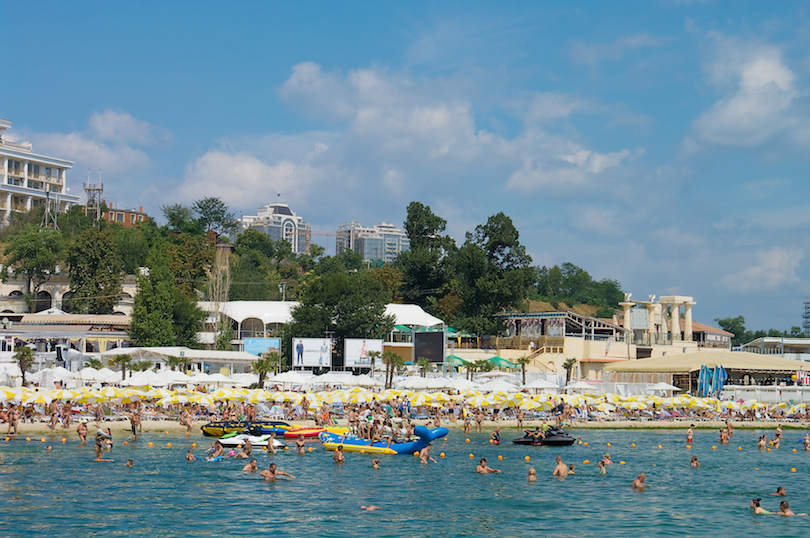
Odessa is a port city on the Black Sea in southern Ukraine. It’s known for its beaches and 19th-century architecture, including the Odessa Opera and Ballet Theater. The monumental Potemkin Stairs, immortalized in “The Battleship Potemkin,” lead down to the waterfront with its Vorontsov Lighthouse. Running parallel to the water, the grand Primorsky Boulevard is a popular promenade lined with mansions and monuments.
Odessa is a warm-water port. The city of Odessa hosts both the Port of Odessa and Port Yuzhne, a significant oil terminal situated in the city’s suburbs. Another notable port, Chornomorsk, is located in the same oblast, to the south-west of Odessa. Together they represent a major transport hub integrating with railways. Odessa’s oil and chemical processing facilities are connected to the Russian and other European networks by strategic pipelines. Before the 2022 Russian invasion of Ukraine the city was a major tourism centre.
Odessa is a major maritime-transport hub that includes several ports including Port of Odessa, Port of Chornomorsk (ferry, freight), Yuzhne (freight only). The Port of Odessa became a provisional headquarters for the Ukrainian Navy, following the Russian occupation of Crimea in 2014. Before the fall of the Soviet Union, the Port of Odessa harbored the major Soviet cruise line Black Sea Shipping Company.
Passenger ships and ferries connect Odessa with Istanbul, Haifa and Varna, whilst river cruises can occasionally be booked for travel up the Dnieper River to cities such as Kherson, Dnipro and Kyiv.
Odessa is linked to the Ukrainian capital, Kyiv, by the M05 Highway, a high quality multi-lane road which is set to be re-designated, after further reconstructive works, as an ‘Avtomagistral’ (motorway) in the near future. Other routes of national significance, passing through Odessa, include the M16 Highway to Moldova, M15 to Izmail and Romania, and the M14 which runs from Odessa, through Mykolaiv and Kherson to Ukraine’s eastern border with Russia. The M14 is of particular importance to Odessa’s maritime and shipbuilding industries as it links the city with Ukraine’s other large deep water port Mariupol which is located in the south east of the country.
Odessa also has a well-developed system of inter-urban municipal roads and minor beltways. However, the city is still lacking an extra-urban bypass for transit traffic which does not wish to proceed through the city centre.
7.Kyiv
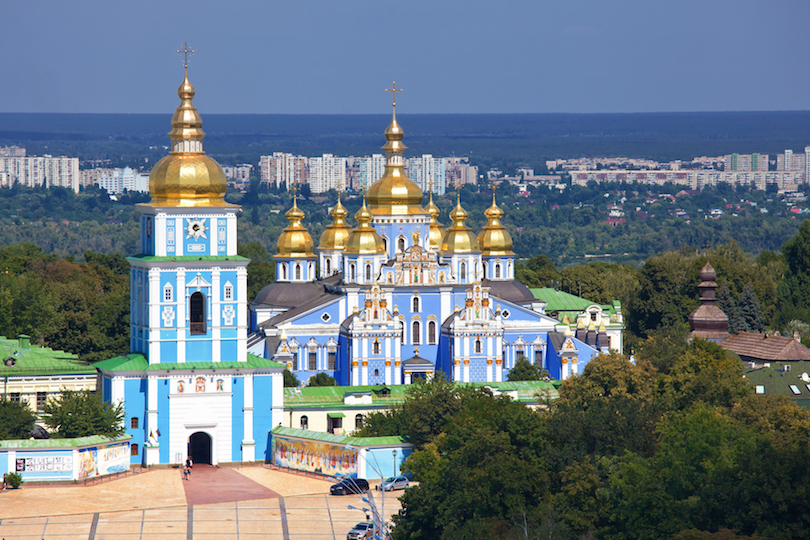
St. Michael’s Golden-Domed Monastery in Kiev, Ukraine
Kyiv or Kiev is the capital and most populous city of Ukraine. It is in north-central Ukraine along the Dnieper River. As of 1 January 2021, its population was 2,962,180, making Kyiv the seventh-most populous city in Europe.
Since introducing a visa-free regime for EU-member states and Switzerland in 2005, Ukraine has seen a steady increase in the number of foreign tourists visiting the country. Before the 2008–09 recession, the average annual growth in the number of foreign visits in Kyiv was 23% over a three-year period. In 2009, a total of 1.6 million tourists stayed in Kyiv hotels, of whom almost 259,000 (ca. 16%) were foreigners.
After UEFA Euro 2012, the city became the most popular destination for European tourists. A record number of 1.8 million foreign tourists was registered then along with about 2.5 million domestic tourists. More than 850,000 foreign tourists visited Kyiv in the first half of 2018, as compared to 660,000 tourists over the same period in 2013. As of 2018, the hotel occupancy rate from May to September averages 45–50%. Hostels and three-star hotels are approximately 90% full, four-star hotels 65–70%. Six five-star hotels average 50–55% occupancy. Ordinary tourists generally come from May to October, and business tourists from September to May.









